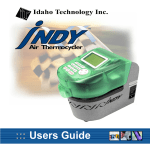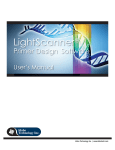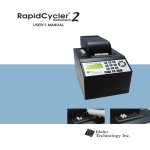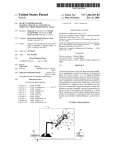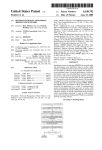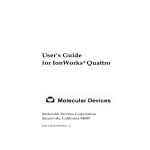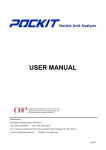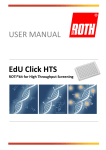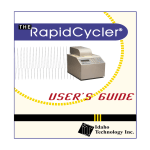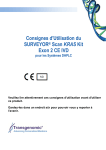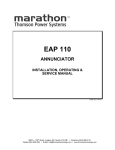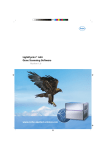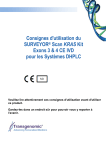Download Manual - VTP UP
Transcript
Lid Optical Baffle Lid Catch Air Vent Status Indicators HR-1™ Instrument © 2003 Idaho Technology, Inc., All rights reserved. 1 ::: Introduction Part# HR01-PRT-0008 HR-1™ Technical Users Manual, Rev - 01 Information in this document is subject to change without notice. No part of this document may be reproduced or transmitted in any form or by any means, electronic or mechanical, for any purpose, without the express written permission of Idaho Technology, Inc. HR-1 Instrument Control software, HR-1 Data Analysis software modules © 2003 Idaho Technology, Inc. RapidCycler, and R.A.P.I.D. are registered trademarks, and LCGreen, HR-1 are trademarks of Idaho Technology, Inc. LightCycler is a trademark owned by a member of the Roche group. U.S. Patent Number 6,174,670, foreign counterparts, and pending patents This product is for research use only. Printed in the United States of America Idaho Technology makes no warranty of any kind with regard to this material, including, but not limited to the implied warranties of merchantability and fitness for a particular purpose. Idaho Technology shall not be liable for errors contained herein or for incidental consequential damages in connection with the furnishing, performance or use of this material. Safety and Regulatory Information This symbol warns the user to operate the machine according to the instructions provided in this manual. If used otherwise, a potentially hazardous situation could result. This symbol is used to label potentially hot instruments surfaces. Caution Hot This symbol highlights user tips to operate The HR-1 instrument more efficiently. Note: Always maintain The HR-1 instrument in good working order. If the instrument experiences an extreme environmental event, return it to Idaho Technology for a complete service inspection. See Appendix A for return instructions. If The HR-1 instrument is used in a manner other than described in this manual, it may impair equipment protection and performance. Introduction ::: 2 HR-1™ Instrument Customer and Technical Support Reach Us On the Web Idaho Technology’s Web site is http://www.idahotech.com Order LCGreen I Reagent Kits at http://www.itbiochem.com We encourage users to visit our Web site for answers to frequently asked questions. The HR-1 instrument manuals, parts and accessories are available online. Reach Us By E-mail Contact Idaho Technology by e-mail in the following areas: [email protected] - Technical Support [email protected] - General Support Reach Us By Phone Technical support is available during the following times. 8 a.m. to 5: 30 p.m. - Mountain Standard Time For technical support call: 1-800-735-6544 - United States and Canada 1-801-736-6354 - Utah IDD Prefix-1-801-736-6354 - International Reach Us By Fax To contact Idaho Technology by fax, use the following numbers: 1-801-588-0507 - United States and Canada IDD Prefix-1-801-588-0507 - International HR-1™ Instrument 3 ::: Introduction Table of Contents Introduction..........................................................................................................5 Chapter 1 - Principles of Mutation Scanning and Genotyping Introduction .....................................................................................................7 Heteroduplex detection ...................................................................................7 Resolution and Reproducibility .......................................................................9 Increased Resolution with LCGreen I dsDNA binding dye .............................9 Genotyping with HR-1 and LCGreen I ..........................................................10 Product Size and Domain Melting ................................................................10 Chapter 2 - Instrument Specifications and Installation Introduction ...................................................................................................13 The HR-1 Instrument ....................................................................................15 Reagent Recommendations..........................................................................16 HR-1 Specifications.......................................................................................17 Setting-Up the HR-1 Instrument....................................................................17 Software Installation ......................................................................................19 Chapter 3 - HR-1 General Operating Instructions Introduction ...................................................................................................21 General Considerations ................................................................................21 Preparation of a DNA Sample ......................................................................22 Amplification ..................................................................................................22 Loading and Unloading a Sample ................................................................23 Chapter 4 - HR-1 Instrument Control Software Introduction ...................................................................................................25 Menu Bar Overview ......................................................................................26 Setting Experimental Conditions ...................................................................29 Starting the HR-1 Instrument control Software. .....................................29 Setting User Name/Profile ......................................................................29 Serial Port Selection ...............................................................................30 View menu ..............................................................................................30 Melting menu ..........................................................................................31 Edit Melting Protocols.............................................................................33 Multiple Sample Experiments .................................................................33 Introduction ::: 4 HR-1™ Instrument Table of Contents LED menu ..............................................................................................34 Tools menu .............................................................................................35 Help menu ..............................................................................................36 Data Organization ..................................................................................36 Melting a Sample....................................................................................38 Suggestions for Higher Throughput .......................................................39 Chapter 5- HR-1 Analysis Software Introduction ...................................................................................................41 Analysis Software Overview .........................................................................41 Additional Sample and Graph Editing Options .............................................45 Data Analysis Introduction ............................................................................45 Opening the Analysis software ...............................................................46 Importing Sample Data...........................................................................46 Normalizing Data ....................................................................................47 X-axis Temperature adjustment..............................................................48 Additional Data Display options .............................................................49 Difference Plot ........................................................................................49 Derivative Plot ........................................................................................51 Cutting and Pasting Graphics ................................................................51 Final Note on Analysis Software ............................................................51 Chapter 6- Troubleshooting Introduction ...................................................................................................53 Hardware Cleaning the Ingot if a Capillary Breaks .................................................53 Lid will not unlock after run ....................................................................55 Instrument does not respond to computer prompts ...............................55 Instrument does not respond when power is turned on .........................56 Software LED Seek Warnings or Failures .............................................................57 Appendix A Equipment Return Procedure .......................................................................59 Return Materials Authorization Fax ...............................................................62 Return & Decontamination Labels ................................................................64 Index ................................................................................................................67 HR-1™ Instrument 5 ::: Introduction Introduction Idaho Technology, the creators of melting curve analysis, introduces the new, powerful, and affordable platform for post-amplification genotyping, gene scanning, and SNP/mutation detection. Utilizing a closed tube DNA amplification reaction with our new LCGreen™ I Dye and the HR-1 High Resolution Melter, users are able to detect different DNA species by observing subtle differences in fluorescent signal over temperature changes. The system can reduce sequencing efforts and cost by greater than 90% by bringing scanning efforts to the bench. The HR-1 System utilizes Roche LightCycler® glass capillary tubes in an aluminum thermal cylinder using single peak excitation (440-470nm) and Introduction ::: 6 HR-1™ Instrument emission (470-520nm) spectra. The fluorescent dye - LCGreen I - is included in the amplification reaction and analysis is performed in a closed tube system. HR-1, in combination with LCGreen I, generates melting curves that exploit the subtle differences between heteroduplex and fully based paired wild type species. The instrument can run 40-45 samples per hour (post amplification) with a 0.3°C/sec ramp rate. Up to 32 samples may be viewed concurrently with the analysis software. The HR-1 system is the only commercially available closed tube homogenous reaction platform to scan for heteroduplexes. HR-1™ Instrument 7 ::: HR-1 Scanning Principles ::: Chapter 1 CHAPTER Principles of Mutation Scanning and Genotyping 1 Introduction This chapter explains general concepts of mutation scanning and genotyping. This includes consideration of heteroduplex DNA molecules, characteristics that facilitate them being distinguished from fully base-paired DNA molecules, and how LCGreen™ I and HR-1 are used to detect heteroduplexes. Genotyping of different homoduplexes by melting temperature is also considered. Heteroduplex Detection A gene which is heterozygous at a particular locus will, upon amplification, create two unique double stranded DNA molecules. If the two molecules differ at a single site within the sequence the products can schematically be shown as in the following image. The heterozygous site may involve one or more nucleotide substitutions, insertions or deletions. If these products are heat denatured and Chapter 1 ::: HR-1 Scanning Principles ::: 8 HR-1™ Instrument then allowed to re-anneal, four DNA duplex species are formed. The double strand molecules with non-Watson/Crick base pairing mismatches are described as heteroduplexes. The perfectly matched duplexes are considered fully base paired. Mismatch base pairing results in heteroduplex molecules that have unique physical properties. The differing physical properties of heteroduplexes include the temperature at which the strands disassociate, or melt. Differing physical properties between heteroduplex molecules and those having fully complimentary base pairing is the basis by which the different species are distinguished to identify heterozygous polymorphisms or mutations. During slow, controlled heating of a heteroduplex, mismatch base pairing causes the strands to disassociate at a lower temperature than fully base paired molecules. LC Green I, a fluorescent double stranded DNA (dsDNA) binding dye, facilitates the observation of this melting process seen as an early loss of fluorescence compared to a sample containing only fully base paired molecules. In the past, distinguishing heteroduplex DNA molecules from fully base paired molecules using fluorescent melting curve analysis met with limited success. Two factors contributed to the inability to effectively detect heteroduplex molecules: 1) Inadequate thermal control of the instrumentation, and 2) shortcomings of dsDNA binding dyes. With the development of LCGreen I, and the improved temperature control and resolution of the HR1 instrument, these issues are resolved in a single, cost effective and simple to use platform. HR-1™ Instrument 9 ::: HR-1 Scanning Principles ::: Chapter 1 The left panel shows the melting curves of a wild type (dark line) and a heterozygous (light line) sample. Note the lower temperature inflection point in the heterozygous sample relative to the fully base paired wild type sample. The right panel shows the derivative plots from the melting curves. Note the single peak in the curve generated by the wild type specimen as compared to the dual-phase peak generated by the heterozygous sample. Resolution and Reproducibility Two samples, one wild type and one heterozygote, were amplified. Analysis was completed and repeated 30 times on HR-1 to measure intra-sample variability. Sample temperatures were recorded at 5% increments of normalized fluorescence for each of the 30 independently assayed samples. Sample temperature standard deviations ranged from 0.006 - 0.045ºC at normalized fluorescence of 10% and 90%, respectively. In addition, 17 different wild type and ten different heterozygote samples were amplified and analyzed for a measure of inter-sample temperature variance. Standard deviations were of similar values with a slightly tighter range (data not shown). These results demonstrate the temperature homogeneity both within and between samples analyzed with LCGreen I on HR-1. Increased Resolution with LCGreen™ I dsDNA binding dye In previous attempts at sequence variant scanning by fluorescent melting curve analysis, the primary shortcoming of dsDNA dyes was a strong inhibitory effect upon amplification at dye concentrations required to sufficiently saturate the newly synthesized product. A consequence of using dsDNA Chapter 1 ::: HR-1 Scanning Principles ::: 10 HR-1™ Instrument binding dyes below a saturating concentration is that the dye molecules redistribute from regions undergoing thermal denaturation to regions that remain double stranded. Dye redistribution effectively eliminates the ability to detect the subtle fluorescence differences characteristic of heteroduplexes via thermal denaturation. LCGreen I can be used at concentrations high enough to saturate the available double stranded binding sites without inhibiting amplification. This characteristic assures product saturation and eliminates the potential for dye redistribution during the melt. The ability to use saturating levels of LCGreen I and the tightly controlled temperature capabilities of HR-1 allow differentiation of the subtle fluorescence changes during the melting transition that occur in a sample containing heteroduplex species. Genotyping with HR-1 and LCGreen™ I HR-1 and LCGreen I were designed to scan for heteroduplexes within amplification products. The high-resolution of the system allows different heterozygotes to be distinguished from each other. That is, different heterozygotes can be genotyped if the controls are available. For example, hemoglobin (Hgb) AS, AC, AE and AS were all distinguishable from each other and the wild type (AA) in a 110 bp fragment of ß-globin (Clinical Chemistry 2003, 49:853-860). Furthermore, it is often possible to distinguish different homozygote base pair changes, for example Hgb AA, SS, and CC. However, some homozygous differences are difficult to detect (A to T and G to C SNPs). When the differences between homozygous genotypes is small, the detection rate will increase when smaller products are analyzed. Product Size and Domain Melting The size of an amplification product that can be successfully analyzed on HR-1 is a variable whose upper limit has not been resolved and may not be governed by a defined set of rules. When products up to 600 bases were systematically studied, all heteroduplexes were detectable when oil was used. Amplification products in the range of 100-250 bases can be rou- HR-1™ Instrument 11 ::: HR-1 Scanning Principles ::: Chapter 1 tinely analyzed on HR-1 and exhibit a single, clean melting transition of the entire product. Localized regions excessively rich or poor in G:C base pairs (resulting in correspondingly poor or rich A:T regions, respectively) may experience "Domain Melting". Domain Melting describes a localized region within a fragment that denatures (melts) at a temperature below that of the remaining portion of the fragment. While both targets were similar in overall G:C content, the fragment showing Domain Melting characteristics has an internal region that is relatively rich in A:T base pairing. The figures above show melting profiles from different target sequences with a single melting domain and a fragment containing high temperature and low temperature melting domains. Domain Melting is most likely to be observed in amplification products over 200 bases, but can also be seen in fragments as small as 100 bases. The presence of multiple, individual melting domains does not preclude effective analysis with HR-1. The primary concern is that melting profiles of different samples align such that differences between samples harboring a sequence variant and those of wild type sequence are distinguishable. The following image shows a dual Domain Melting profile where heteroduplexes are present in the high temperature and low temperature domains where both variants are readily discernible from fully base-paired molecules. HR-1™ Instrument Chapter 1 ::: HR-1 Scanning Principles ::: 12 Wild Type Het 2 Het 1 Het 2 Wild Type Het 1 Domain Melting profiles from a fragment with a unique sequence variant in both domains. Three samples (WT, Het1, and Het2) were analyzed in duplicate. Het1 contained a sequence variant in the low temperature domain, while Het2 harbored a sequence variant in the higher temperature domain. Because the melting profiles were grouped so tightly, the variants were observed quite easily with a preliminary indication that each sample contained a unique variant in different portions of the fragment. HR-1™ Instrument 13 ::: Instrument Specifications and Installation ::: Chapter 2 CHAPTER 2 Instrument Specifications and Installation Introduction This chapter contains general and technical information about the HR-1 instrument, including specifications, installation requirements, and installation instructions. It is included for those who will install and perform routine maintenance on the HR-1 instrument. Using the system improperly may compromise performance or permanently damage the instrument. HR-1™ Instrument Chapter 2 ::: Instrument Specifications and Installation ::: 14 Lid Lid Catch Caution Hot Optical Baffle Status indicators Air Vent Cooling Fan Ingot Lid Catch Solenoid HR-1™ Instrument 15 ::: Instrument Specifications and Installation ::: Chapter 2 The HR-1 Instrument The HR-1 instrument consists of a single heat controlled ingot (machined aluminum cylinder) positioned above an optics block that functions as an excitation and data collection source. Sample analysis is performed in a Roche LightCycler™ capillary tube. While there is a clear advantage to performing amplification in a capillary tube, amplification may be performed in other containers and subsequently transferred to a Roche capillary for analysis. The fluorescent dye LCGreen™ I is included in the amplification reaction. The HR-1 platform is the only homogenous system to scan for heteroduplexes. A single sample may be scanned in 30-120 seconds (dependent on ramp rate and temperature range), and up to 32 samples may be viewed concurrently with the analysis software. There are three indicator lights on the front of the instrument. All three lights come on when the instrument is turned on. During instrument operation, the lights function as follows: Steady Green light - indicates instrument power is on. Flashing Red light - indicates instrument is melting a sample and the lid is locked shut Flashing Amber light - indicates instrument is unlocked and ready to analyze another sample HR-1™ Instrument Chapter 2 ::: Instrument Specifications and Installation ::: 16 Components of the HR-1 System HR-1 Instrument Package Laptop computer (pre-loaded with HR-1 Instrument Control and Data Analysis software) Software installation CD HR-1 Startup Kit, includes Manual and Cables HR-1 Tool Kit Power Kit 1 Box Roche LightCycler capillaries (96 capillaries) HR-1/LC Green I Chemistry Kit (only available with HR-1 instrument purchase) 100 µl of LCGreen I 10x dye 1 ml 10X Buffer with BSA 10 mM MgCl2 1 ml 10X Buffer with BSA 20 mM MgCl2 1 ml 10X Buffer with BSA 30 mM MgCl2 1 ml of Enzyme diluent 1 ml of 10X BSA - 2.5 mg/ml 400, 1,000 and 10,000 LCGreen I Reaction Kits are available from Idaho Technology. Reagent Recommendations LCGreen™ I dye is to be used at 1X final concentration. BSA is to be used at 1/10 concentration (0.25 mg/ml). This is to help avoid adsorption of nucleic acids to glass capillaries. It is not necessary to add this to the sample if the sample already contains buffer with BSA. Buffered MgCl2 solutions for amplification is to be used at 1/10 concentration (supplied as 10X, includes BSA). Enzyme diluent is to be used to dilute enzyme (includes BSA). HR-1™ Instrument 17 ::: Instrument Specifications and Installation ::: Chapter 2 HR-1 Specifications Temperature sensing is acquired using a platinum resistive thermal device (RTD) embedded inside the machined cylinder. Fluorescence detection is initiated with an excitation source that is compensated for temperature drift and stability. Intensity of the excitation source is controlled by a 12-bit digital to analog converter that varies the current to the excitation source. Fluorescence detection is achieved using a single wavelength, siliconbased, hybrid photodiode and amplifier. Ramp rates of 0.01ºC to 1.0ºC are attainable from ambient temperature to 100ºC. Control of the HR-1 instrument is serial based to a laptop computer. - Instrument requires 100-240 VAC 50-60 HZ and consumes approximately 40 Watts of power - 12W max single sample heater with 12-bit control - 28mA max LED excitation with 12-bit control - 24-bit temperature and fluorescence detection - Optics include single color excitation and single color detection - Temperature ramp rates from .01 to 1ºC per second - Temperature ramp range from ambient to 100ºC Setting-Up the HR-1 Instrument 1. Unpack the instrument by carefully removing it from the sealed box. Refer to the packing list to ensure that all of the components are included. 2. Place the instrument on a clean, well ventilated lab bench. Make sure there is 10 cm of space behind the instrument to ensure adequate airflow for cooling of electronic components. Transport the instrument by placing one hand underneath and one hand on top or on the side of the instrument. Do not carry the instrument by the hinged lid. Chapter 2 ::: Instrument Specifications and Installation ::: 18 HR-1™ Instrument Placing the instrument in a room that is kept at a relatively cool temperature will facilitate more efficient cooling of the heated ingot upon completion of a melt (20-25ºC). 3. Connect the USB to serial converter to the laptop and then connect the serial cable between the converter and the HR-1's serial port. It is not recommended to connect or disconnect the USB/serial cables while the laptop is running. 4. Make sure the power switch located on the back of the instrument is in the OFF position before you plug in the power cord. Connect the HR-1 and laptop power cord to a grounded power supply. 5. The instrument is now ready to be turned on. Serial Port Power Switch Power Cord receptor HR-1™ Instrument 19 ::: Instrument Specifications and Installation ::: Chapter 2 Software Installation The HR-1 Software Package is designed specifically for Microsoft Windows 2000 or XP Operating Systems. Administrative rights to the computer are required to install and run the software package on other computers. The software installation will require up to 19 MB of disk space. All HR-1 software must be run at a screen resolution of 1024 x 768. HR-1 software package - All software for running the HR-1 and analyzing data is pre-installed on the HR-1 laptop. The software is located under the Idaho Technology folder in the Programs directory. An installation CD is provided for re-installation or installation of the analysis software package on multiple computers. Be sure to back-up data before re-installation of software. To Install the Software Insert the HR-1 CD into the CD drive. The installation wizard will automatically start up. If the installation wizard does not prompt, browse to the CD drive, select the HR-1 software file and choose the setup.exe file. After selecting the installation location, the Installer will present three options: Typical, Compact, and Custom. Typical Installation - This will install all the software needed to run the HR-1 Instrument and analyze the data it produces. Compact Installation - This option will only install the HR-1 Instrument Control software. This option is for users where HR-1 data analysis is to take place on a different computer than the one controlling the HR1 Instrument. Custom Installation - Allows the user to choose individual components of the HR-1 software to install on the system. Chapter 2 ::: Instrument Specifications and Installation ::: 20 HR-1™ Instrument HR-1™ Instrument 21 ::: HR-1 Instrument Operating Instructions ::: Chapter 3 CHAPTER HR-1 General Operating Instructions 3 Introduction This chapter details the steps for preparing samples and loading them into the HR-1 for analysis. General Considerations The HR-1/LCGreen™ platform directly analyzes the melting behavior of double-stranded DNA. LCGreen I dye binds to any dsDNA present. Therefore, care in preparation of the DNA sample to be assayed is critical for generating optimal results. Factors that influence results, obtained using the HR-1, include the nature of the DNA specimens being analyzed and factors influencing thermal denaturation of a DNA fragment. Analysis on the HR-1 requires that defined DNA fragments are present, usually produced by amplification. The buffer and ionic strength are especially important and must be controlled from sample to sample. The HR-1 analyzes specimens in Roche LightCycler® capillary tubes. These tubes are designed for the LightCycler instrument and are also com- Chapter 3 ::: HR-1 Instrument Operating Instructions ::: 22 HR-1™ Instrument patible with the Idaho Technology RapidCycler® 2 and R.A.P.I.D.® systems. A clear benefit of amplification in Roche LightCycler™ capillaries is that after amplification the tube may be transferred directly to the HR-1 for analysis. Additionally, when using the LightCycler, amplification may be monitored in real-time using fluorescence Channel 1. Amplification may be performed in other reaction vessels, however, the specimen must be transferred to a Roche LightCycler capillary prior to analysis in HR-1. Amplification reactions of 10 µl are effectively analyzed by HR-1 and this volume is recommended, however, reaction volumes of 5-20 µl can also be used. A small volume oil overlay may provide even greater precision when added prior to amplification. Preparation of a DNA Sample Numerous methods exist to prepare DNA from a variety of sources. Any variation in salt concentration between samples will adversely affect precision of the melting curve. To a lesser extent, variation in the DNA concentration can also affect melting profiles. When assaying groups of samples it is advisable that they be adjusted to a uniform concentration in the same buffer. Variable results have been observed with samples that have been archived for significant periods of time. It is strongly recommended that archived DNA samples be re-purified, eluded in a standard buffer, and quantified before use with the HR-1 system. Following re-purification archival specimens perform as well as newly prepared specimens. Amplification Amplification can be performed any number of ways in the presence of LC Green™ I dye. It must be robust and performed prior to analysis on the HR1. Amplification may be done in Roche capillaries or transferred to them post amplification for analysis on the HR-1. It is possible to use an oil overlay with the amplification and leave it in place for the analysis on the HR1. Oil overlay has been shown to be beneficial with repetitive melts on the HR-1™ Instrument 23 ::: HR-1 Instrument Operating Instructions ::: Chapter 3 same sample. Melting profile similarity between like samples is critical to the ability to distinguish differing melting profiles of samples harboring a sequence variant. If the melting profiles of different samples show more variation than is desirable, it may be useful to add a mineral oil overlay (2-5 µl). The mineral oil should be applied prior to amplification. Because of the exceptional resolution of HR-1, small irregularities between samples related to evaporation/ condensation during amplification or during a melt on HR-1 may have an effect on the salt or dsDNA concentration, post-amplification, between samples. This may cause "artificial" differences between melting curves of perfectly homologous samples. A small volume mineral oil overlay will prevent this from occurring, and has the effect of "tightening" up the melting profiles to a degree that it is sometimes even possible to distinguish a homozygous base change between samples. Loading and Unloading a Sample All melting curves must be performed in Roche LightCycler capillaries. The heated ingot in the HR-1 instrument is designed so that the capillaries fit firmly into the slot. Care must be taken when inserting and especially when removing a sample as the capillaries become more fragile when they are heated. Loading a Sample 1. To load a sample into HR-1, simply place the end of the capillary into the hole on the top of the ingot and allow the capillary to "seat" itself. Manufacturer tolerances for the capillaries and heated ingots cause some capillaries to be loaded quite easily, while others Chapter 3 ::: HR-1 Instrument Operating Instructions ::: 24 HR-1™ Instrument will need some amount of delicate pressure to be positioned correctly within the ingot. Make sure the capillary is completely seated down in the ingot before the lid is shut. 2. Shut the lid and use the software to begin melting. Removing a Sample 1. When removing a capillary, use two fingers to slide/twist the capillary up and out of the ingot. Take special care not to place excessive side-to-side directional force on the capillary as it is pulled out of the ingot (as more of the capillary is removed from the ingot, the less pressure is required to break the capillary with a sideways directional force). HR-1™ Instrument 25 ::: The HR-1 Instrument Control Software ::: Chapter 4 CHAPTER HR-1 Instrument Control Software Introduction This chapter contains instructions on how to operate the HR1 instrument through the Control Software. 1. To open the software, locate the software icon on the Desktop. 2. Using the mouse, double-click on the icon which will take you to the main screen. 4 Chapter 4 ::: The HR-1 Instrument Control Software ::: 26 HR-1™ Instrument Menu Bar Overview File - Options access basic user interface functions Serial Port- Designates computer serial interface to the HR-1. Com1, Com2, etc. Set User Name - Accesses Enter Users menu for different operators. Pull Down Selection menu - Allows user to select user name and add new user names. OK - Accepts pull-down menu selection. Cancel - Cancels out of Set User Name window. Remove User - Removes selected user from pull down menu. Exit - Exits from HR-1 instrument control software. View - Alternates between view panes and data streaming options Real Time Graph - Checkable option to monitor HR-1 in real-time. Melting Graph - Checkable option to monitor HR-1 recorded experimental fluorescent trace. Pause Data - Pauses and re-starts real-time graphing updates. Fluorescence and temperature data is continuously displayed in the upper left status bar. Clear Data - Clears stored temperature and fluorescence data on both graphs. Accessible when instrument is not melting. Melting - Accesses melting experiment conditions and controls Start Melting - Opens Start Melting window. Start - Begins selected melting protocol. The instruments lid must be closed for this to operate. New Protocol - Opens the Edit Melting Protocol dialogue window. Allows the user to create a new protocol. Edit Protocol - Opens the edit Melting Protocol Dialogue window. HR-1™ Instrument 27 ::: The HR-1 Instrument Control Software ::: Chapter 4 Allows the user to view and edit an existing protocols. Cancel - Closes Start Melting dialog window. Melting Analysis - Launches the HR-1 analysis software (if installed). Abort Melting - Stops the current melting experiment. Existing data is saved under the experiment name. It will also abort a hold. Melting Protocols - Opens melting protocol directory. Protocols can be examined and edited (right mouse click). LED - Accesses the LED controller options Adjust LED Power - Accesses the LED power dialog window. Power Slide Bar - Use to manually adjust LED power setting. Power output will be indicated by percentage in the dialog window. Close - Exits Adjust LED Power dialog window. Save - Saves adjustments made to the LED power level to the current melting protocol. Turn LED on - Turns LED on when not in an active melting protocol. Turn LED off - Turns LED off when not in an active melting protocol. Tools - Accesses HR-1 Hardware/Firmware controls Set Hold Temperature - Opens the Set Hold Temperature dialog window. User can then select from 20 to 70º C. Selecting the OK button instructs the instrument to heat or cool and then hold the ingot at the desired temperature. Only available when the instrument is not melting. Chapter 4 ::: The HR-1 Instrument Control Software ::: 28 HR-1™ Instrument Instrument cannot hold a temperature lower than ambient - setting a hold temperature lower than ambient will cause the cooling fan to run resulting in an error prompt reading Unable to reach xx degrees, cooling aborted. xx is the selected cool temperature The instrument will not accept hold temperature greater than 70º C for safety reasons. Reset Instrument - Re-initializes the firmware and internal hardware components. Accessible when instrument is not melting. Instrument Name - Records a unique name for the instrument. Instrument name is logged in data files. Update Firmware - Opens the Update Firmware Dialog. Accessible when instrument is not melting. Used only when new firmware is provided by Idaho Technology. Done - Closes the Update Firmware Dialog. Browse - Opens an Open File dialog to find the firmware .HEX file. Refresh - Refreshes the displayed instrument version. Update - Updates the instrument with the selected firmware .HEX file. Remove File - Removes the currently selected file from the drop down list. Help - Accesses the User Help Functions About HR-1 - Opens the About Dialog. OK - Closes the About Dialog. Reset - Re-initializes the firmware and internal hardware components. Accessible when instrument is not melting. User Manual - Accesses the electronic version of the User's Manual. Idaho Technology Technical Support - Links Users to the Idaho Technology Technical Support by email (compatible with Mozilla and Outlook, not compatible with Outlook Express). HR-1™ Instrument 29 ::: The HR-1 Instrument Control Software ::: Chapter 4 Setting Experimental Conditions Starting the HR-1 Instrument Control Software Confirm the HR-1 instrument control software is loaded onto the hard drive, the instrument is connected by the serial cable, and the power on the HR-1 instrument is on. If any of these items are not in place, refer to Chapter 2. 1. To start the HR-1 Instrument Control software by double-clicking on the HR-1 Instrument Control icon on the desktop. 2. The Enter Username dialog window will appear. Use the pull down menu to select the User Name. This will allow the user to access any preset protocols stored under the User Name. Setting User Name/Profile To change the User Name without shutting down the instrument or software, select Set User Name from the File menu, and change the user on the pull down menu. To Create a new user, simply type the new User Name in the Set User Name window. To delete a User Name, select the User Name to be deleted from the pull down menu and choose Remove User. Deleting a User Name results in all protocols saved under that User Name also being deleted. Protocols saved as Global will remain even if all users are removed. Chapter 4 ::: The HR-1 Instrument Control Software ::: 30 HR-1™ Instrument Serial Port Selection Select the correct Serial Port from the File menu. The information bar at the bottom of the software window will give information about the HR-1 instrument communication with the PC. The information bar will display connection status (PC Com port), machine ID, current user, melting protocol being used, and the status of the machine (melting, holding, cooling, etc.). Select the proper Com port that is attached to the HR-1 instrument. View Menu Under the View menu, there are two options for display status. The Real Time Graph will display a split screen where the user can observe, in "real time", the temperature of the heated ingot and the continuous fluorescent status of the sample in the top screen. The corresponding melting curve data (fluorescence vs. temperature) will appear in the lower screen. The Melting Graph option will display only the melting curve of the sample (the lower screen from the Real Time Graph option) in the full screen of the software window, but will not display the temperature or fluorescence over time. A digital display of the temperature and fluorescent signal is always present in the information bar just below the menu bar at the top of the software window. Pause Data and Clear Data are also options in this window (refer to definitions at the beginning of this chapter). HR-1™ Instrument 31 ::: The HR-1 Instrument Control Software ::: Chapter 4 Melting Menu To start a melting curve, select Start Melting from the Melting menu. The Start Melting window will appear with the currently selected melting protocol and the default file name for the sample to be melted. The default file name is a DateTime stamp, but can be changed by typing in the desired file name. If the currently selected file name is appropriate, load a sample, shut the lid, and choose Start to begin the melting curve. To edit or verify that the currently selected melting protocol is correct select the Edit Protocol button. To select a different melting protocol, use the pull down menu to choose the correct protocol. A new Melting Protocol can be created by choosing the New Protocol button (Note: It is recommended to melt the first sample of a new experiment in order to verify the pathway to which the file will be saved). The Edit Protocol button opens a dialog window with the parameters for the currently selected melting protocol displayed in the melting parameter fields. Melting parameters can be modified in this window or the pull down menu can be used to select a preset melting protocol saved under the current user's name. Chapter 4 ::: The HR-1 Instrument Control Software ::: 32 HR-1™ Instrument Melting Protocol Name - Defines protocol name which must be unique to the User and Global list. Repeat Melting - Automatically prompts the Start Melting window with a previous protocol for repetitive runs. Ramp Rate - Rate of temperature change for the melting profile (0.01 - 1.0º C per second). Final Temperature - Ending High temperature melting curve (100º C max). Cool Temperature - Temperature the HR-1 will cool to after the Final Temperature is reached. Hold Cool Temp - Selectable feature to hold HR-1 at a staging temperature for repeated melts to aid in throughput (20-70º C programmable range). Acquisition Start Temperature - Temperature when the HR-1 melting profile begins acquiring fluorescent data. Directory - Location where melting data files are stored. Data files have a .vs2 extension. Excitation Power - LED power setting for the melt protocol. Auto Set - The HR-1 automatically determines the optimal starting LED power setting based on the target fluorescence. Target Fluorescence (%) - Target scale setting for Auto Set fluorescence (99% max). HR-1™ Instrument 33 ::: The HR-1 Instrument Control Software ::: Chapter 4 Edit Melting Protocols The Melting Protocol Name, Temperature transition rate (Ramp Rate), beginning (Cool Temperature) and ending temperatures (Final Temperature), the location to which the melting file is saved (.vs2 extension), and the Target Fluorescence (%) can be modified in this menu. Multiple Sample Experiments If several samples are to be melted during the same session, check the Repeat Melting and Hold Cool Temp boxes. This will automatically bring up the Start Melting window with the file name highlighted following each melting protocol, and will hold the ingot at the specified cool down temperature until the next melting protocol is started. A new sample name can be entered while the previous sample and ingot are being cooled. When editing or creating a new melting protocol, it is recommended that the Cool Temperature be set at least 10 degrees below the Acquisition Start Temperature to allow the instrument time to gain sufficient control of the heated ingot prior to the initial acquisition of data. If the Auto Set check box is checked, the instrument will automatically adjust LED power to acquire the desired fluorescence target level from each sample. If the Auto Set box is unchecked, the user specifies a standard LED power that will be used on each sample. Checking the Auto Set box is advisable when the assay conditions have been optimized and the user wishes to perform the final analysis on each sample. Leaving the Auto Set box unchecked may be useful when determining how much fluorescence is present in individual samples relative to each other or compared to other experimental conditions. Melting acquisition can be stopped at any time by selecting Abort Melting from the Melting menu. Data is continuously logged during a melting protocol, and any data that has been logged will be saved under the file name. Chapter 4 ::: The HR-1 Instrument Control Software ::: 34 HR-1™ Instrument Melting protocols can be created and edited by choosing New Protocols under the Melting menu. To edit an existing protocol, right click on the protocol and select Edit Melt Protocol. To create a new protocol, right click on the user name for the person designated for the new protocol. Under the Melting menu, the analysis software package can be opened by selecting Melting Analysis. LED Menu The HR-1 instrument can be used as a real time fluorimeter to check the fluorescent status of a sample under different LED power settings. This function gives an accurate measure of the strength of fluorescent signal in a sample and an indication of the fluorescent acquisition parameters to set in the melting parameter fields (see Melting menu above). To turn the LED on, select Turn LED On under the LED menu. Click on Adjust LED Power under the LED menu to view the effect of different LED power settings on the fluorescent signal in a sample. The LED is automatically turned on when this option is used. To turn off the LED, choose Turn LED Off under the LED menu. HR-1™ Instrument 35 ::: The HR-1 Instrument Control Software ::: Chapter 4 Tools Menu The Tools menu accesses functions related to sample fluorescent excitation. After the HR-1 instrument is turned on, the instrument may be pre-warmed by choosing Set Hold Temperature under the Tools menu. A limit of 70ºC has been set for safety. If the instrument stops responding during a melting acquisition or at any other time, the instrument may be "rebooted" without power cycling or shutting down the software. To complete this, choose Reset Instrument under the Tools menu. If the Reset Instrument function does not correct the problem, turn the instrument off, shut down the software, and restart software and/or computer. The name of the instrument can be edited or changed by selecting Instrument Name in the Tools menu. Chapter 4 ::: The HR-1 Instrument Control Software ::: 36 HR-1™ Instrument The Update Firmware option in Tools is available should Idaho Technology release firmware upgrades. Further instructions for use of these functions will follow through new product and upgrade announcements to HR-1 customers. Help Menu The HR-1 User’s manual can be accessed in Adobe Acrobat PDF format by selecting the User Manual option under the Help menu. Selecting the About HR-1... menu selection will bring up the about window describing the software version. There are two selectable options OK and Reset. Selecting OK will return to the main screen. Selecting Reset performs the same function as the Reset Instrument selection in the Tools menu. If the problem is not resolved with the instrument or software, please call Idaho Technology's customer service. Data Organization It is important to organize the data you will collect with the HR-1 instrument. Setting-up a main folder for all of the data that will be collected is recommended, with separate folders within the main folder that identify different targets, experimental conditions, users, etc. All fluorescence and temperature data for each sample is stored in a single file (.vs2 extension). Based on the software characteristics, an example is included of how to organize and name different folders and files for efficient data retrieval. HR-1™ Instrument 37 ::: The HR-1 Instrument Control Software ::: Chapter 4 This method of data organization will allow the selection of individual samples for analysis, or multiple samples from different experimental conditions to compare all at once. The analysis software will automatically display the differences in the pathways to the samples in the sample names column, allowing easy identification of which samples you are analyzing and what the different experimental conditions were for each sample. For example, to analyze Sample 1 and 2 from both experimental conditions in Exon 1, the sample name list would look like: /Condition /Condition /Condition /Condition 1/Sample 1/Sample 2/Sample 2/Sample 1 2 1 2 Once the optimal experimental and melting conditions have been determined, a Final Results folder can be created to perform the definitive analysis on all samples, allowing easy analysis for all samples under the same final conditions, and keeping data well organized in a standard format. Melting a Sample After the capillary is properly seated in the ingot, (Chapter 2 - loading and unloading a sample) close the lid, Chapter 4 ::: The HR-1 Instrument Control Software ::: 38 HR-1™ Instrument and select Start Melting in the Melting menu. Use the pull down menu to select the protocol. Select Edit Protocol to examine that all melt parameter fields are correctly filled. To melt more than one sample under the same conditions, check the Repeat Melting box. By checking the Repeat Melting box, the Start Melting window will automatically open after the a melting protocol is completed and the ingot has been cooled to the specified temperature. Check the Hold Cool Temp box for the instrument to maintain the cool down temperature between melting acquisitions. There are two options for fluorescence acquisition in the Edit Protocol window. Select the Auto Set box to automatically adjust the LED power to achieve a specified level of fluorescence from the sample. Uncheck the Auto Set box to use a standard LED power level on all samples. Confirm the path where the sample file will be saved ( choose the Browse button to change the path and Save when the desired path is found). The Start Melting window will return, upon completion of Protocol editing (choose OK or cancel). HR-1™ Instrument 39 ::: The HR-1 Instrument Control Software ::: Chapter 4 Name the sample in the file name text area, load the sample capillary in the instrument, close the lid, and select Start Melting. The lid will lock at this time, and cannot be opened until the ingot is cooled to the specified Cool Temperature (maximum cool down temperature is 70ºC). During melting acquisition it is possible to change the display window to display the Real Time Graph or the Melting Graph. When the melting curve is finished, the file is automatically saved and the HR-1 instrument runs the cool down fan until the ingot reaches the specified Cool Temperature. When the cool down is complete, the lid will unlock. The lid may be opened and the sample removed at this point. Follow the procedure to melt additional samples. It will not be necessary to check all of the melt parameter fields if several samples are melting under the same conditions. Type in the name of each new sample in the Start Melting window and select Start Melting for subsequent samples. Suggestions for Higher Throughput The process of melting samples can be expedited by performing a test run through a temperature range of 70ºC up to 96ºC. Following this protocol, analyze the melting transition that occurs and choose a temperature range that will provide adequate data prior to and following the primary melting transition. It may be helpful to use the derivative plot function to help pinpoint the maximal melting transition point, indicated by the Tm of the resulting peak. To determine the temperature range prior to and following the melt, use the following calculation based on ramp rate (15 x Ramp Rate = # of ºC to set the acquisition temp prior to the initial melting transition of the fragment). An example: 15 x 0.3º ramp rate = 5. Set acquisition temperature 5º prior to the melting transition and end melt 5º post transition. Following this procedure, it is possible to collect the relevant data within a smaller temperature range minimizing the amount of time required per sample. Chapter 4 ::: The HR-1 Instrument Control Software ::: 40 HR-1™ Instrument Use caution in setting the lower temperature as some heteroduplex transitions can occur 5-10ºC below the primary melting transition. HR-1™ Instrument 41 ::: HR-1 Analysis Software ::: Chapter 5 CHAPTER HR-1 Instrument Analysis Software 5 Introduction This chapter describes the basic concepts about the HR-1 Data Analysis software package. Chapter 5 is a step by step guide to the analysis process. Analysis Software Overview Menu Bar File New Files - Import new .vs2 files for analysis. Add Files - Add .vs2 files to current analysis. Sample Names As Input - default setting, displays sample names as they Chapter 5 ::: HR-1 Analysis Software ::: 42 HR-1™ Instrument were originally entered. Unique Characters - displays only the unique characters in the sample names list, all common characters in the sample names will be displayed in the graph title. Change - Changes sample names. Export Graph Data - Creates a tab/space delimited text file for use in external database or spreadsheet applications. Print Print Window - Opens the systems default printer window. Page Setup - Change print parameters and layout. Exit - Close analysis software. Edit - Edit functions are operable only if graph tools have been used in the analysis. Undo Move - Undoes movement caused by use of the graph tools. Redo Move - Redoes graph movement after use of Undo Move. Select Original Data - Default setting, uses all time/temp/fluorescence data logged by HR-1. Limit by Time/Temp - Allows user to define the time/temperature ranges to analyze. Melting Curves - Default setting, shows data as a fluorescence vs. temperature plot. Kinetics - Shows data as a fluorescence vs. time plot. Time/Temp - Plots the temperature vs. time, gives an indication of temperature control. HR-1™ Instrument 43 ::: HR-1 Analysis Software ::: Chapter 5 Analyze Normalize - Normalizes fluorescence data before and after the melting transition. Temp Shift - Force all samples to overlay over a defined temperature/ fluorescence range. Difference Plot - Graphical plot of the difference between samples at each data point. Derivative Plot - Graphical plot of the rate of fluorescence change. Derivative peaks give an approximation of the melting temperature (Tm) of a sample. Display Show Cursors - Displays vertical and horizontal adjustable cursors. Show Run Data - Displays information about the melting parameters that were used on the samples. Show Graph Tools - Displays some basic graph tools on the chart allowing the user to manipulate the appearance of the graph. Graph Title File Name - Default setting, displays the graph title as the pathway to the files that are being analyzed. Rename - Allows the alteration of the name of the graph. Show S/N - Displays the Signal to Noise ratio for each sample in a tabular format. Plots All - Default setting, displays the melting curves of all the samples. Chapter 5 ::: HR-1 Analysis Software ::: 44 HR-1™ Instrument None - Clears the display area of all melting curves. Every 2nd - displays every 2nd sample 3rd - displays every 3rd sample 4th - displays every 4th sample Subset 1st half - displays the first half of the sample list 2nd half - displays the second half of the sample list 1st third - displays the first third of the sample list 2nd third - displays the second third of the sample list 3rd third - displays the last third of the sample list Invert - Clears the samples that are currently displayed and displays all other samples on the list. Style Color - Default setting, sample curves are displayed in different colors with various line and point styles for easier discrimination between samples. Black and White - Displays samples as a spectrum of thin to thick, gray to black lines. User - Select a previously saved User Style (see Save User Style below). Replicates Duplicates - Displays samples as duplicates of each other. (Sample 1 and 2, Sample 3 and 4, etc.) Triplicates - Displays samples as triplicates of each other. Quadruplicates - Displays samples as quadruplicates of each other. By Last Alphanumeric - Uses the last alphanumeric character to identify sample replicates. HR-1™ Instrument 45 ::: HR-1 Analysis Software ::: Chapter 5 Save User Style - Saves sample editing changes for the current analysis. About HR-1 v1.1 - Shows the current version of analysis software. Additional Sample and Graph Editing Options Right click on any sample color line to change color, line style, line width, point style, etc. Select the first or last number on either the X or Y axis to change the scale of the axis. Select a Graph Tools icon from the Graph Tools palette (located just off the lower left corner of the graph) and and drag within the graph. This also activates the Edit functions. Data Analysis Introduction The approach to analysis of data from the HR-1 will be based on the specific application. Whole amplicon melting curve analysis most commonly is used to scan for heteroduplex formation. It can be used for genotyping as well. When scanning for heteroduplex formation, heteroduplexes are identified by a change in shape of the melting curve from fully base paired wild type samples. Distinguishing factors include the slope of the primary melting transition, the lowest temperature at which heteroduplex samples deviate from wild type samples, and the temperature at a given fluorescence level. Although quantitative measures can be devised, observation of the entire curve and comparison to wild type is the best method for identifying heteroduplexes. Chapter 5 ::: HR-1 Analysis Software ::: 46 HR-1™ Instrument Opening the Analysis Software To open the HR-1 analysis software, select the HR-1 melt analysis tool desktop icon, or choose Melting Analysis under the Melting menu in the HR-1 Instrument Control software. A full screen window will open along with a browsing window. Importing Sample Data A window will appear prompting selection of analysis files. Browse to the location of the melting files, and choose the Select Current Directory. This will open a sample list window in the HR-1 analysis package. All .vs2 files in the directory are selected for analysis by default. If only a subset of the samples is to be analyzed, select the samples to analyze while holding the Shift key (for blocks of samples) or choose individual samples to view. Select Continue when finished. The raw data from each sample selected will be displayed on the initial screen, with the pathway to the samples shown as the Graph Title, and individual Sample Names displayed on the selectable upper left portion of the graph. To open additional, or new sample files, select Add Files or New Files in the File menu, respectively. Add Files automatically returns to the last directory selected. Selecting New Files opens the default browser window. HR-1™ Instrument 47 ::: HR-1 Analysis Software ::: Chapter 5 Normalizing Data The first step in analyzing the samples is to normalize the fluorescence data by selecting Normalize in the Analyze menu. This opens a window that shows 4 vertical cursors numbered 1-4. Cursors 1 and 2 should be moved (select and hold with mouse to move) to identify a linear region of the melting curves prior to the major melting transition of the sample(s). Cursors 3 and 4 should be moved to identify a linear region of the melting curve(s) following the melting transition of the sample(s). The cursors must be kept in the same numeric order, relative to each other, from left to right. When normalizing the melting curves, the original data will appear in the upper panel of the screen, while the lower panel of the screen will show a preview of the final curves after normalization. The cursors are initially placed at default positions, although it is often necessary to adjust them. All of the curves should appear in the lower panel preview area. Positioning of the cursors during the normalization process is critical to further analysis of the samples. If samples did not amplify, or "no template" controls were present, these samples will not normalize properly. Eliminate these samples from consideration by selecting "Delete Some Bad Samples" or "Delete All Bad Samples". It is possible to exclude "bad" samples by simply not selecting them for the final analysis. There are no set rules for positioning the cursors. Brief experimentation of different cursor placements will display the functioning of the cursors and the different effects . As a general rule, it is advisable to include a larger temperature range between each set of cursors as ramp rate increases. At a ramp rate of 0.3ºC per second, a temperature range of at least 0.5ºC between cursors is desirable. After the data has Chapter 5 ::: HR-1 Analysis Software ::: 48 HR-1™ Instrument been normalized, all samples will have a "flat" slope before and after the melt. This makes further analysis of the melting portion of the curves easier to interpret. X-axis Temperature Adjustment The most common application on the HR-1 is scanning amplified products for heteroduplexes. For this application X-axis temperature adjust of data is necessary following normalization. Temperature adjust the curves by choosing Temp Shift under the Analyze menu. A window will open displaying the normalized curves in the top panel, and a preview of the temperature adjusted curves in the lower panel. Temperature adjustment forces each curve through the same temperature range as defined by the placement of the horizontal cursors. This is useful for heteroduplex analysis in that differential melting curve shapes are more easily distinguished, allowing for positive identification of a sample harboring a sequence variant. The default placement of the horizontal cursors shown in the middle graph is adequate in most cases. If the cursors need adjustment, left click the mouse and hold on the cursors to move them. It is recommended that the cursors be kept as close to the bottom, and as close to each other as possible, thus ensuring the curves will be adjusted and forced through the highest temperature point of the melting transition. Use the bottom graph to judge the effect of cursor adjustments. A list of sample names is shown, with a graphical representation of the data points included in the current range defined by cursor placement for each sample in the middle panel. Select from this list the sample to represent the "reference" curve. All other curves will be "fit" to this reference sample curve. Choosing a different reference sample for this analysis has little effect on the outcome, but is provided as a standardization tool when a HR-1™ Instrument 49 ::: HR-1 Analysis Software ::: Chapter 5 true standard sample has been run for comparison purposes. As with normalization, there are no set rules for cursor placement but experimentation will quickly provide the necessary experience to become proficient in X-axis temperature adjustment. Additional Data Display Options While Normalizing and X-axis temperature shifting are the only steps required for most analysis, there are two additional options for viewing data in different formats which are useful in making the determination of whether or not a sample contains a sequence variant, or whether the sequence variant observed in one sample is the same as that observed in another sample. Difference Plot The Difference Plot function provides a graphical method of looking at the temperature difference between two, or several, samples throughout the selected temperature range. Under the Analyze menu, select Difference Plot. A window will open with the samples listed in the upper left portion. Select a reference sample - It is represented by the horizontal line in the graph area. The difference between each sample and the reference sample is calculated and Melting curves of 2 heterozygous samples with different mutations in the same target sequence. Some differences are observed in the melting curves, but they are still quite similar. HR-1™ Instrument Chapter 5 ::: HR-1 Analysis Software ::: 50 displayed for each data point in the comparison. The Y-axis is auto scaled based on the largest difference between samples. The Difference Plot may be a useful tool to determine whether or not a suspected sequence variant in one sample is potentially a different sequence variant than that observed in another sample. It can be difficult to make this determination by looking only at the melting curves. The Difference Plot and Derivative Plot (described below) provide displays that may allow distinction between 2 different sequence variants. Essentially, subtle differences between variant sample melting curves are magnified and easily observed using these two graphical display options. Wild Type Heteroduplex Heteroduplex Wild Type Melting curves (left panel) and Difference Plots (right panel) of 3 different Heterozygous samples with the same mutation. Note how the heteroduplex curves are identical in both graphs, as are the curves of the WT samples. HR-1™ Instrument 51 ::: HR-1 Analysis Software ::: Chapter 5 Derivative Plot To display the Derivative Plot, choose Derivative Plot under the Analyze menu. The negative derivative of fluorescence is plotted on the Y-axis with Temperature on the X-axis. Melting "peaks" are displayed, allowing easy visualization of differences between the samples. The peak of the curves is known as the Tm (Melting Temperature). Tm is the temperature at which the DNA duplexes are denaturing at their greatest rate. The Derivative Plot may be useful for identifying differences in the type of mutation present in individual samples. The Derivative Plot analysis option is the only analysis option available if the melting curves have not been normalized. Cutting and Pasting Graphics To cut graphics from the analysis software, hold the CTRL key while simultaneously selecting the PRINT SCRN key on the computer keyboard (CTRL+Print Scrn). Paste the image into an appropriate graphics handling program as a Bitmap (.BMP) using the CTRL+V function. Final Note on Analysis Software There is much data analysis functionality within the software that can be found by experimentation. The instructions provided in this User's Manual are sufficient for familiarization required to perform practical and functional analysis of data and give the basics for further analysis. Chapter 5 ::: HR-1 Analysis Software ::: 52 HR-1™ Instrument The Derivative Plot and the Difference Plot of two heterozygous samples with different mutations from previous figures. Note the differences between the two heterozygous samples. HR-1™ Instrument 53 ::: Troubleshooting ::: Chapter 6 CHAPTER 6 Troubleshooting Introduction This chapter details some problems that may arise with the instrument or software, and steps you can take to resolve these issues. It is a simple trouble shooting guide. If a problem persists with the instrument or software, please contact Idaho Technology’s customer support at 1-(800)-7356544. Hardware Before attempting any manipulation of the hardware described in this chapter, turn off and unplug the instrument from any power source and disconnect the serial cable from the computer. Cleaning the Ingot after Breaking a Capillary Caution Hot Before attempting to clean the heated ingot, cool the ingot to a temperature that is safe to handle (40ºC or below). Wear gloves before attempting to clean the ingot with a broken capillary tube. Change gloves often during the procedure to reduce the risk of contamination. Chapter 6 ::: Troubleshooting ::: 54 Solution 1. Turn off the instrument and unplug it from the electrical outlet before beginning the procedure for cleaning the ingot. 2. Use the small Phillips head screwdriver supplied in the HR-1 Tool Kit to remove the two small screws that hold the plastic cover on and carefully remove the cover to expose the ingot. 3. Carefully, and thoroughly clean the ingot and the area around the ingot with a swab and 10% bleach solution. 4. Detach the connector running from the ingot to the interior of the HR-1 instrument. 5. Remove the two small hex head screws with the hex head driver tool supplied in the HR-1 Tool Kit and carefully lift the ingot off the two positioning posts that protrude through the ingot's circuit board. 6. Clean the conical portion of the bottom of the ingot with the diluted bleach solution. Clean the interior of the ingot with the small wire brush and diluted bleach solution. Repeat as necessary. 7. Using a lens cleaning cloth, clean the lens under the ingot with a diluted bleach solution followed by water. HR-1™ Instrument HR-1™ Instrument 55 ::: Troubleshooting ::: Chapter 6 8. Place the ingot over the positioning posts and re-seat the assembly. 9.Re-attach the connector to the ingot. 10. Replace the two small hex head screws but do not tighten either of them down until both screws have been started in their respective holes. Care should be taken NOT to over tighten these screws. 11. Replace the plastic cover and the two small Phillips head screws. Lid will not Unlock after Run Solution Tap gently on the top of the instrument. Listen for the latch to release and open the lid. Do not attempt to open the lid with any force if the latch is stuck. This can bend the latch and cause it to become inoperable. Instrument does not Respond to Computer Prompts Solution 1 Check the Com Port selection to verify the right com port has been chosen. Incorrect com port selection results in an inability of the computer to communicate with the HR-1. Solution 2 If the instrument stops responding during melting acquisition or at any other time, it is possible to "reboot" the instrument without turning the instrument off and on or shutting down the software. To “reboot” the HR-1, select Reset Instrument under the Tools menu. If the Reset Instrument function does not correct the problem, turn the instrument HR-1™ Instrument Chapter 6 ::: Troubleshooting ::: 56 off, shut down the software, and re-initialize the software and/or reboot the computer. Power Light does not Light up when Power is Turned on Solution Unplug the HR-1 from the wall socket. Disconnect the Serial cable from the back of the panel. Check fuses on the back panel of the instrument. If a fuse is blown, replace with 1amp 250 volt 3AG fuses (this information is also located on the back serial plate) using the following diagram and description. The fuse assembly is located next to the power switch. 1. Place a flathead screwdriver in the small slot to pop the fuse assembly out of the mounting hole. The fuse assembly will pop up when the plastic latch is released. 2. Replace with properly rated fuses. Insert assembly into mounting and snap it in place. Fuse Access Serial Plate HR-1™ Instrument 57 ::: Troubleshooting ::: Chapter 6 Software LED Seek Warnings or Failures Solutions 1. Re-melt sample. 2. The sample is not giving enough fluorescence to reach the required levels specified in the melting protocol. Adjust target fluorescence percentage or re-optimize amplification protocol to obtain higher fluorescence. If Auto Set Fluorescence is used, all samples should be analyzed using the same target fluorescence level. Chapter 6 ::: Troubleshooting ::: 58 HR-1™ Instrument HR-1™ Instrument 59 ::: Return & Decontamination Forms ::: Appendix A Appendix Return & Decontamination Forms A To return a machine or product for replacement or repair, follow the basic guidelines for decontaminating and returning the machine or product. Once the forms have been filled out and the appropriate steps have been taken, fax or e-mail the forms to Idaho Technology at (801) 588-0507 or [email protected]. The following forms have been provided: • • • • Equipment Return Procedure RMA Return Fax Return & Repair Form Decontamination Labels For more information please visit our Web site at www.idahotech.com or by phone: 1-800-735-6544 or 1-801-736-6354. Appendix A ::: Return & Decontamination Forms ::: 60 HR-1™ Instrument Equipment Return Procedure Obtain an RMA Number The first step in returning an instrument to Idaho Technology is to obtain an RMA number from our Service Department. Fill out the supplied fax forms (2 pages) and fax them to Idaho Technology at (801) 588-0507. Our Service Representative will contact you with an RMA number and further instructions. If your machine is still under warranty, please supply the purchase date and serial number, if your machine is out of warranty, please supply a blank PO# for the repair charges. Decontamination all Returned Equipment Equipment returned to Idaho Technology for repair and other reasons must be handled in a manner which will ensure minimal risk to the personnel involved in packing the unit for return; and those responsible for receipt, unpacking and processing at Idaho Technology Inc. To ensure there is no loss of data any computers being retuned must be backed up prior to shipment. Idaho Technology is not responsible for any lost data. Decontamination The person responsible for the return must thoroughly decontaminate the unit wiping it down with 0.5% NaOCl (chlorine bleach diluted 1 part bleach to 9 parts water). Use care not to mix with other chemicals (mixture with acid will liberate chlorine gas). Since the solution is somewhat caustic, gloves and a face shield are recommended when preparing and using the solution. When corrosion by NaOCl may be a problem, a flush with water is permissible after the NaOCl has remained in contact for a minimum of 10 minutes. HR-1™ Instrument 61 ::: Return & Decontamination Forms ::: Appendix A Decontamination Labels After the above steps have been completed, the person responsible for the return must complete and sign two Decontamination Labels and attach one to the instrument and the other to the exterior of the shipping container. Complete and sign the Decontamination Form; a photocopy should be made for your records and the original must be returned with the instrument. A Return Materials Authorization Number (RMA#) must be obtained from Idaho Technology prior to shipment and the RMA# and Decontamination Labels must be visible on the exterior of the shipping container. Idaho Technology reserves the right to return and or refuse receipt of any materials at the customer’s expense, that do not meet these requirements. Packaging and Shipping The HR-1 case is to be wrapped in a plastic bag before it is inserted into the box. There is to be at least 2” inches of foam or packaging material on the bottom of the heavy weight box (recommended box size 24” x 20” x 12”.) Place the wrapped HR-1 back side down with the start up kit directly next to the machine. Place 2” or more inches of foam or packaging material all around the instrument. International Shipping If a HR-1 instrument is shipping internationally it MUST have a license and is to be shipped via an Idaho Technology preferred carrier. To find a preferred carrier for your region, contact our shipping department at 801-7366354. A Return Materials Authorization Number (RMA#) must be obtained from Idaho Technology prior to shipment and the RMA# and Decontamination Labels must be visible on the exterior of the shipping container. Idaho Technology reserves the right to return and or refuse receipt of any materials at the customer’s expense, that do not meet these requirements. HR-1™ Instrument Appendix A ::: Return & Decontamination Forms ::: 62 Return Materials Authorization Fax From: ____________________________________ pg. 1 of 2 Pages: _____ _____________ Attn: _____________________________________ Ship to: Idaho Technology Inc. 390 Wakara Way Salt Lake City, UT 84108, USA (801) 736-6354 Warranty:___________ Non-Warranty:_______ Date: ____________________________________ RMA#: __________________________________ (Return Materials Authorization*) Company: ________________________________ Department: _______________________________ PO#: ____________________ Phone: ___________________________________ Fax: _____________________ Model: ___________________________________ Serial No. ________________ Notes: ________________________________________________________________ _____________________________________________________________________ _____________________________________________________________________ Please read and completely fill out the Return Machine Packet found on the Internet at http://www.idahotech.com/product_sup/forms.htm. The decontamination form and labels must be completed before the machine is returned to Idaho Technology. In the event the unit is returned without documentation it will be shipped back to you at your expense. Non-warranty charges are $70/hr. with a 2 hr. minimum charge plus parts and shipping charges. In the event the unit cannot be repaired, it will either be returned to you or disposed of upon your request. Thank you for your business and support of the health and well being of our employees. Signature: ________________________________ Date: ____________________ *User must contact Idaho Technology prior to returning the instrument to receive an RMA# HR-1™ Instrument 63 ::: Return & Decontamination Forms ::: Appendix A Return Materials Authorization Fax pg. 2 of 2 If your machine is still under warranty, please supply the purchase date and machine serial number, if your machine is out of warranty, please supply a blank PO# for the repair and shipping charges. Please note that your item must be returned with an Idaho Technology assigned RMA# and Decontamination documentation. Prior to returning the item you must contact Idaho Technology for an RMA number and also fax copies of all necessary Decontamination Forms to: Fax (801) 588-0507, Attn: Technical Support. All returns should be sent to the following address: Idaho Technology, Inc. 390 Wakara Way Salt Lake City, UT 84108, USA (801) 736-6354 Declaration of Decontamination This instrument has be decontaminated in accordance with an established government regulation or equivalent, rendering it free from radioactive, biological, or chemical contamination. Which Method was Used? __________________________________________ What chemical, infectious, toxic or radioactive substances have been in contact with this product? (Also indicate if flammable or corrosive.) ---Authorization Notice By accepting this authorization to return this product, the user assumes all responsibility for decontamination and cleaning. Idaho Technology Inc. reserves the right to refuse the delivery of products, which do not appear to have been properly decontaminated. If the equipment was used with or around radioactive material, the signature of the safety officer is also required. Signature: ________________________________ Date: ____________________ _________________________________________________________________________ Customer Address: _________________________________________________________ Customer Name: ___________________________________________________________ Idaho Technology Return Authorization (RMA#): ___________________________________ This Product has been decontaminated per Return Equipment policy: _________________ Decontamination Notice: Appendix A ::: Return & Decontamination Forms ::: 64 Fill out the decontamination Labels and affix one to the product and the other to the exterior of the shipping carton. Failure to decontaminate before shipping to Idaho Technology Inc. will result in the immediate return of the unit at your expense. Decontamination Labels HR-1™ Instrument Pg. 1 of 2 _________________________________________________________________________ Customer Address: _________________________________________________________ Customer Name: ___________________________________________________________ Idaho Technology Return Authorization (RMA#): ___________________________________ This Product has been decontaminated per Return Equipment policy: _________________ Decontamination Notice: HR-1™ Instrument 65 ::: Return & Decontamination Forms ::: Appendix A Fill out the decontamination Labels and affix one to the product and the other to the exterior of the shipping carton. Failure to decontaminate before shipping to Idaho Technology Inc. will result in the immediate return of the unit at your expense. Decontamination Labels Pg. 2 of 2 Appendix A ::: Return & Decontamination Forms ::: 66 HR-1™ Instrument HR-1™ Instrument 67 ::: Index Index H A Heteroduplex ........................8 Heteroduplex detection .........7 Heterozygous ........................7 Higher Throughput ..............39 Amplification .......................22 Analysis Software ...............46 Auto Set Fluorescence .......57 C Cleaning the Ingot ..............53 Clear Data ...........................26 Com Port .............................55 Control Software .................25 Customer Support .................2 I Importing Sample Data .......46 Installation ...........................13 Introduction ...........................5 K D Kinetics ...............................42 Data Display Options ..........49 Data Organization ...............36 Decontamination .......... 58, 59 Derivative Plot .............. 43, 51 Difference Plot ............. 43, 49 Domain Melting ...................10 L LCGreen™ I dsDNA binding dye ........................................9 Loading a Sample ...............23 M F Fuses ..................................56 G Genotyping .........................10 Graph Editing Options ........45 Melting Graph .....................26 Melting Protocols ......... 27, 33 Multiple Sample Experiments . .............................................33 Mutation Scanning and Genotyping ...........................7 HR-1™ Instrument Index ::: 68 U N User Name/Profile ..............29 Normalizing Data ................47 W O Wild type ...............................9 Operating Instructions .........21 X P Packaging and Shipping .....60 Pause Data .........................26 Preparation of a DNA Sample .............................................22 Product Size .......................10 R Reagent Recommendations 16 Removing a Sample ...........24 Reset Instrument ................28 Resolution and Reproducibility ...............................................9 RMA Number ......................59 S Serial Port ...........................30 Set Hold Temperature .........27 Set User Name ...................26 Setting-Up ...........................17 Software Installation ...........19 T Table of Contents ..................3 Technical Support .................2 Temp Shift ...........................43 Troubleshooting ..................53 X-axis Temperature Adjustment 48 HR-1 Instrument Specifications Linear Ramp Rate 0.01°C to 1°C per second Temperature Range Ambient to 100°C Data Acquisition 24 bit temperature and fluorescence analog to digital conversion Sample Volume 5-20 µl using Roche LightCycler capillary tubes. Capacity/Throughput Single sample capillary melter. Typical 40-45 samples per hour with a 0.3°C ramp rate Laptop Computer Dell Notebook Computer with Ethernet capabilities Software Windows based software includes control and analysis modules Size 4 x 5.5 x 12 inch / 10.2 x 14 x 30.5 cm (w x h x d) Weight 5.8 lbs. / 2.65 kg Power Supply 100 to 240 VAC, 1.3 Amp, 50/60 Hz universal power









































































